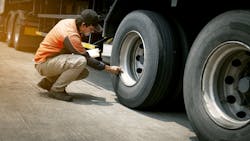The harsh winter climate can negatively affect the performance of heavy-duty vehicles and might be the culprit for tire inflation pressure (PSI) loss and decreased fuel mileage. Proactive tire maintenance could help save truckers from missing deadlines due to issues resulting from underinflated tires. Here’s what truckers need to know about the changing temperatures and tire PSI as we inch closer to the spring season.
Changes in air temperature affect the speed of air molecules in a tire, thus resulting in a fluctuation of PSI. This means that a truck starting its long-haul trip in Florida may notice a dramatic change in PSI by the time it reaches its destination in Colorado. Hot tires can affect the sound of a tire, in addition to the pressure. Tires coming off the highway may see a 15% increase in inflation pressure compared to cold tires. Cold inflation is based on room temperature of 68 degrees Fahrenheit and does not include any inflation pressure buildup due to vehicle operation.
See also: Managing commercial truck tires in real time
Drivers will not be able to tell the exact pressure rating of the tires just by looking at them. Therefore, it is important to recognize the common symptoms of under-inflation including: the TPMS light illuminating on dashboards; reduced steering and handling; longer stopping distance; increased road vibrations; and flapping noises coming from the tires. If any of these sound familiar, it is likely time to inflate tires to avoid trouble down the road.
Driving with underinflated tires
You may be wondering what will happen if you drive with underinflated tires. Running a tire under the recommended PSI can reduce tread life and cause a substantial reduction in fuel economy. When tires are under-inflated, the rubber to ground ratio is off and leads to an increase in friction. In turn, it causes overheating and premature wear and tear on tires (or even a blowout).
The U.S. Department of Transportation has mandatory minimum requirements for tread depth on all commercial vehicles, 4/32-in. for the steer tire position and 2/32-in. in all other positions to ensure commercial truck tires have the appropriate level of tread for operation. Because of these DOT requirements, truckers will want to inspect tires for proper PSI and tire tread before making deliveries and pickups.
See also: Understanding the tire/fuel efficiency equation
Exploring the numbers
PSI is a unit of measurement that is up for debate within the trucking community. When looking at the right PSI amount for inflation, the consensus is that PSI in heavy-duty applications will be based on several factors, including the maximum load capacity of each vehicle. Other factors include whether trucks are using “steer” or “drive” tires; the brand of tires; and the size of the tires.
There is a maximum cold inflation pressure stamped on wheel rims that should not be ignored. It is usually set at 120, 130, or 140 PSI. In most cases, steer tire pressure can be set at 110 PSI while drive tire pressure can be around 85 PSI. Tire inflation can be measured using a universal tire pressure gauge like a stick gauge. This type of tire pressure gauge has a 3 PSI plus or minus accuracy rating and can be verified for accuracy using a master gauge.
To use a stick gauge, drivers will simply remove the valve cap from each tire and place the pressure gauge on the valve stem. Then, press down hard enough to hear a hissing noise that will tell them the PSI amount for each tire. If tires are set below 85-110 PSI, it is time for inflation.
The jury is still out on the perfect PSI numbers; but one thing is for sure, the weather outside can affect tire pressure and how many trips to the gas station you make to refuel. As we approach the spring season, be sure to pre-inspect tires for appropriate tire pressure levels based on application and other factors including maximum load capacity and tire size. With these tips, drivers can cruise the open road without worrying about blowing tires and missing deadlines.
Jennifer Smith is an ecommerce digital content specialist for JIT Truck Parts.
About the Author
Jennifer Smith
Jennifer Smith is an e-commerce digital content specialist for JIT Truck Parts. With distribution centers located throughout the U.S., JIT offers customers parts from leading.
